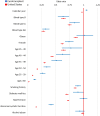Disparities in donor heart acceptance between the USA and Europe: clinical implications
- PMID: 37936176
- PMCID: PMC10659950
- DOI: 10.1093/eurheartj/ehad684
Disparities in donor heart acceptance between the USA and Europe: clinical implications
Abstract
Background and aims: Given limited evidence and lack of consensus on donor acceptance for heart transplant (HT), selection practices vary widely across HT centres in the USA. Similar variation likely exists on a broader scale-across countries and HT systems-but remains largely unexplored. This study characterized differences in heart donor populations and selection practices between the USA and Eurotransplant-a consortium of eight European countries-and their implications for system-wide outcomes.
Methods: Characteristics of adult reported heart donors and their utilization (the percentage of reported donors accepted for HT) were compared between Eurotransplant (n = 8714) and the USA (n = 60 882) from 2010 to 2020. Predictors of donor acceptance were identified using multivariable logistic regression. Additional analyses estimated the impact of achieving Eurotransplant-level utilization in the USA amongst donors of matched quality, using probability of acceptance as a marker of quality.
Results: Eurotransplant reported donors were older with more cardiovascular risk factors but with higher utilization than in the USA (70% vs. 44%). Donor age, smoking history, and diabetes mellitus predicted non-acceptance in the USA and, by a lesser magnitude, in Eurotransplant; donor obesity and hypertension predicted non-acceptance in the USA only. Achieving Eurotransplant-level utilization amongst the top 30%-50% of donors (by quality) would produce an additional 506-930 US HTs annually.
Conclusions: Eurotransplant countries exhibit more liberal donor heart acceptance practices than the USA. Adopting similar acceptance practices could help alleviate the scarcity of donor hearts and reduce waitlist morbidity in the USA.
Keywords: Comparative study; Donor selection; Health policy; Heart failure; Heart transplant; Risk factors.
© The Author(s) 2023. Published by Oxford University Press on behalf of the European Society of Cardiology. All rights reserved. For permissions, please e-mail: journals.permissions@oup.com.
Figures







Comment in
-
Crossing the chasm of donor organ recovery in heart transplantation.Eur Heart J. 2023 Nov 21;44(44):4675-4677. doi: 10.1093/eurheartj/ehac707. Eur Heart J. 2023. PMID: 37936195 No abstract available.
References
-
- Khush KK, Cherikh WS, Chambers DC, Harhay MO, Hayes D, Hsich E, et al. The International Thoracic Organ Transplant Registry of the International Society for Heart and Lung Transplantation: thirty-sixth adult heart transplantation report—2019; focus theme: donor and recipient size match. J Heart Lung Transplant 2019;38:1056–66. 10.1016/j.healun.2019.08.004 - DOI - PMC - PubMed
-
- Sorabella RA, Guglielmetti L, Kantor A, Castillero E, Takayama H, Schulze PC, et al. Cardiac donor risk factors predictive of short-term heart transplant recipient mortality: an analysis of the united network for organ sharing database. Transplant Proc 2015;47:2944–51. 10.1016/j.transproceed.2015.10.021 - DOI - PMC - PubMed
MeSH terms
Grants and funding
LinkOut - more resources
Full Text Sources
Medical

